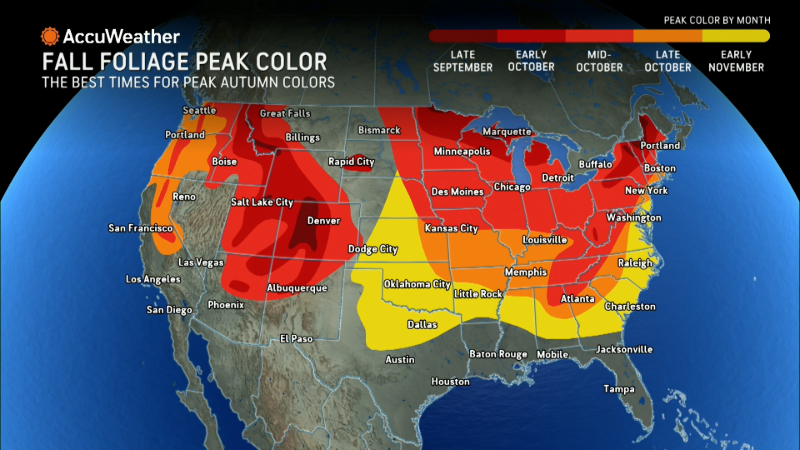Brewing tropical storm in Caribbean brings risk of flooding, damaging winds into late October
The next tropical storm may take shape in the Caribbean, where it may intensify into a hurricane before the end of October. The next Atlantic tropical storm will be named Melissa.
AccuWeather Lead Hurricane Expert Alex DaSilva speaks on the recent development of a tropical wave that heads into the Caribbean with thunderstorms.
The warm waters of the Caribbean Sea have been mostly untouched this hurricane season, making the region prime for tropical development. Combined with lower wind shear, or disruptive winds higher up in the atmosphere, the conditions in the Caribbean look favorable for tropical development by the middle of this week.
For over a week, AccuWeather meteorologists have been monitoring the Caribbean for potential tropical development around late October. On Monday night, a tropical rainstorm formed in the eastern Caribbean, just west of the Lesser Antilles.
"The tropical rainstorm in the Caribbean is likely to further intensify into a named storm in the next few days," said AccuWeather Lead Hurricane Expert Alex DaSilva, adding that a powerful hurricane is also possible.
The next Atlantic tropical storm will be named Melissa.

As it intensifies, the tropical system is expected to move rather slowly to the north or northwest, over or just to the west of the mountainous island of Hispaniola, and it may even stall over the region.
A broad zone of 1-2 inches of rainfall will occur across much of the Caribbean, including places like San Juan, Puerto Rico.

Due to the slow-moving nature of the tropical rainstorm, round after round of heavy, tropical downpours will drench portions of Hispaniola, Cuba and Jamaica. In this zone, rainfall totals can easily surpass a foot, with an AccuWeather Local StormMax™ of 30 inches.
This amount of rain is particularly concerning given Haiti's ecological makeup and its lack of trees due to deforestation.
"Without trees across Haiti to help absorb some of the rain, days of tropical rainfall would bring an extreme risk for mudslides and life-threatening flooding," DaSilva said.

Due to extreme flooding risk and strong winds, this tropical rainstorm is a two on the AccuWeather RealImpact™ Scale for Hurricanes for the Caribbean.
As the rainstorm begins to strengthen in the Caribbean, wind gusts of 40-60 mph will impact parts of Jamaica, Haiti and Cuba as soon as Thursday. Stronger wind gusts of 60-80 mph with an AccuWeather Local StormMax™ of 100 mph can occur closer to the shore.

The strong winds can bring down trees, power lines and cause some structural damage. Power outages can last for days where the strongest winds occur.
GET THE FREE ACCUWEATHER APP
• Have the app? Unlock AccuWeather Alerts™ with Premium+
By the start of next week, the storm will be at a crossroads. The jet stream strength and location will be the biggest influence on the track of the rainstorm moving forward.
"While we think that the chances of a direct U.S. hit from this storm are low right now, it's still on the table should the tropical system make it into the western Caribbean," warned DaSilva.

Historically, tropical systems that reach the western Caribbean in October are more likely to be steered away from places like Texas and Louisiana. But the eastern United States, and Florida in particular, can still be impacted by intense storms.
In recent years, Hurricane Wilma of 2005 rapidly strengthened in the western Caribbean before being pulled west of Cuba and then across southern Florida as a powerful hurricane. In 2018, Hurricane Michael was named in the western Caribbean before rapidly intensifying in the Gulf, becoming a Category 5 hurricane and striking the Florida Panhandle.
Even though the official end of the Atlantic tropical season is only about 45 days away, more tropical activity is still possible in the coming weeks.
“Less than 12 percent of the Atlantic hurricane season is left, climatologically speaking, but no one should let their guard down," DaSilva said. "The return of La Niña conditions can lead to atmospheric patterns that are conducive to late-season tropical storm development.”

Want next-level safety, ad-free? Unlock advanced, hyperlocal severe weather alerts when you subscribe to Premium+ on the AccuWeather app. AccuWeather Alerts™ are prompted by our expert meteorologists who monitor and analyze dangerous weather risks 24/7 to keep you and your family safer.
Report a Typo














